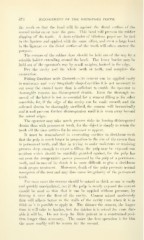Page 676 - My FlipBook
P. 676
674 MANAGEMENT OF THE DECIDUOUS TEETH.
the tooth so that the bead will lie against the distal surface of the
second molar on or near the gum. This bead will prevent the rubber
slipping oif the tooth. A short cylinder of bibulous paper can be tied
in the ligature and ai)p]i<'d with the same effect, and even a large knot
in the ligature on the distal surface of the tooth will often answer the
purpose.
The corners of tiie rul)b(>r dam should be held out of the way by a
suitable holder extending around the head. The lower border may be
held out of the operator's way by small weights, hooked in the edge.
Dry the cavity and the whole tooth or teeth, and complete the
excavation.
Pilling- Cavities with Cement.—As cement can be applied easily
in undercuts and very irregularly shaped cavities it is not necessary to
cut away the enamel more than is sufficient to enable the operator to
thoroughly remove the disintegrated dentin. Even the thorough re-
moval of the latter is not as essential for a cement filling as for other
materials, for, if the edge of the cavity can be made smooth and the
softened dentin be thoroughly sterilized, the cement will hermetically
seal it and prevent further disintegration until it is worn away beyond
the sound edges.
The operator may take much greater risks in leaving disintegrated
dentin than with permanent teeth, for the object is simply to retain the
tooth till the time arrives for its successor to appear.
It must be remembered in excavating cavities in deciduous teeth
that the pulp is much larger in proportion to the size of the crown than
in permanent teeth, and that in trying to make undercuts or retaining
grooves deep enough to retain a filling, the pulp may be exposed—an
accident which should be carefully guarded against, for the pulp has
not even the recuperative power possessed by the pulp of a permanent
tooth, and in case of its death it is more difficult to give a deciduous
tooth proper treatment. Moreover, death of the pulp prevents normal
resorption of the root and may thus cause irregularity of the permanent
teeth.
For most cases the cement should be mixed as thick as can be easily
and quickly manipulated, but if the pulp is nearly exposed the cement
should be used so thin that it can be applied without pressure, by
flowing it over the floor of the cavity. Cement mixed moderately
thin will adhere better to the walls of the cavity than when it is as
thick as it is possible to apply it. The thinner the cement, the longer
time it will take to harden, but the thicker it is mixed the more dur-
able it will be. Do not keep the little patient in a constrained posi-
tion longer than necessary. The easier the first operation is for him
the more readily will he return for the second.


